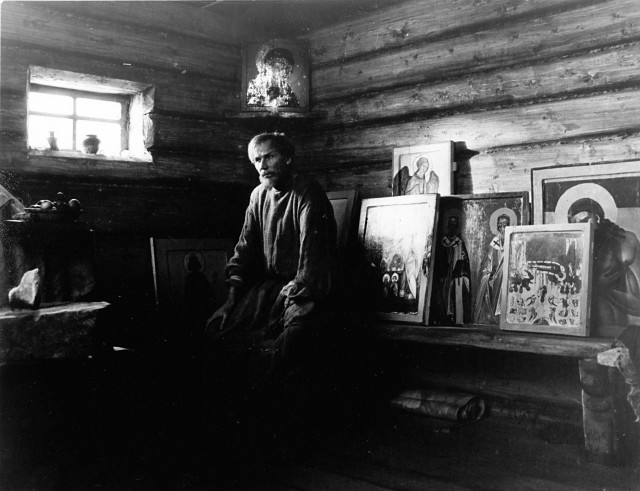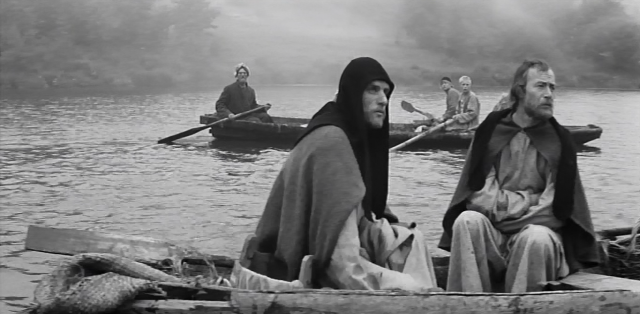ANDREI RUBLEV (ANDREY RUBLYOV) (Andrei Tarkovsky, 1966)
Museum of Arts & Design
2 Columbus Circle at 58th St. & Eighth Ave.
Friday, July 31, $10, 7:00
Series continues Friday nights through August 28
212-299-7777
madmuseum.org
 Soviet auteur Andrei Tarkovsky followed up his dazzling debut, Ivan’s Childhood, with the three-and-a-half-hour epic Andrei Rublev, a quietly powerful tale of a monk and icon painter making his way through early fifteenth-century Russia. But it is much more than a historical, biographical look at the real-life figure during the creation of tsarist Russia. “I knew it would certainly not be a historical or biographical work,” Tarkovsky wrote in his 1986 book Sculpting in Time. “I was interested in something else: I wanted to investigate the nature of the poetic genius of the great Russian painter. I wanted to use the example of Rublyov to explore the question of the psychology of artistic creativity, and analyse the mentality and civic awareness of an artist who created spiritual treasures of timeless significance.” The film begins with a seemingly unrelated prologue in which a man named Yefim (Nikolay Glazkov) takes off in a hot-air balloon as the townspeople try to prevent him from flying, as if he is defying God by soaring in the sky. Tarkovsky then spreads out his tale over the course of eight vignettes, some of which feature Rublev (Anatoly Solonitsyn) as a minor character, more of a background observer than the protagonist. A gentle, slow-moving man with a deep contemplation of existence, Rublev, along with his traveling companions and fellow painters Daniil (Nikolai Grinko) and Kirill (Ivan Lapikov), encounters a skomorokh (Rolan Bykov) performing in a barn before being interrupted by the authorities; meets up with aging master Theophanus the Greek (Nikolai Sergeyev); has a falling-out with Kirill; is joined by a new apprentice, Foma (Mikhail Kononov); comes upon a pagan bacchanalia in the woods; befriends the beautiful holy fool Durochka (Irma Raush, Tarkovsky’s wife at the time); finds himself in the middle of a power struggle between the grand prince and his brother, leading to a brutal Tatar invasion; takes a vow of silence after committing a major sin; and watches as a young boy, Boriska (Nikolai Burlyayev, who played Ivan in Tarkovsky’s feature debut), leads the construction of a church bell in a small town, the ropes surrounding the lifting of the bell referencing the ones that Yefim hung from earlier, each trying to get closer to God in their own way.
Soviet auteur Andrei Tarkovsky followed up his dazzling debut, Ivan’s Childhood, with the three-and-a-half-hour epic Andrei Rublev, a quietly powerful tale of a monk and icon painter making his way through early fifteenth-century Russia. But it is much more than a historical, biographical look at the real-life figure during the creation of tsarist Russia. “I knew it would certainly not be a historical or biographical work,” Tarkovsky wrote in his 1986 book Sculpting in Time. “I was interested in something else: I wanted to investigate the nature of the poetic genius of the great Russian painter. I wanted to use the example of Rublyov to explore the question of the psychology of artistic creativity, and analyse the mentality and civic awareness of an artist who created spiritual treasures of timeless significance.” The film begins with a seemingly unrelated prologue in which a man named Yefim (Nikolay Glazkov) takes off in a hot-air balloon as the townspeople try to prevent him from flying, as if he is defying God by soaring in the sky. Tarkovsky then spreads out his tale over the course of eight vignettes, some of which feature Rublev (Anatoly Solonitsyn) as a minor character, more of a background observer than the protagonist. A gentle, slow-moving man with a deep contemplation of existence, Rublev, along with his traveling companions and fellow painters Daniil (Nikolai Grinko) and Kirill (Ivan Lapikov), encounters a skomorokh (Rolan Bykov) performing in a barn before being interrupted by the authorities; meets up with aging master Theophanus the Greek (Nikolai Sergeyev); has a falling-out with Kirill; is joined by a new apprentice, Foma (Mikhail Kononov); comes upon a pagan bacchanalia in the woods; befriends the beautiful holy fool Durochka (Irma Raush, Tarkovsky’s wife at the time); finds himself in the middle of a power struggle between the grand prince and his brother, leading to a brutal Tatar invasion; takes a vow of silence after committing a major sin; and watches as a young boy, Boriska (Nikolai Burlyayev, who played Ivan in Tarkovsky’s feature debut), leads the construction of a church bell in a small town, the ropes surrounding the lifting of the bell referencing the ones that Yefim hung from earlier, each trying to get closer to God in their own way.

Tarkovsky classic explores the nature of faith and sin and art and creativity as seen through the eyes of several Russian icon painters
At a surprisingly fluid pace despite the film’s length, Tarkovsky and cowriter Andrei Konchalovsky (Runaway Train, Maria’s Lovers) explore such issues as sin, guilt, fear of God, vanity, loyalty, jealousy, poverty, and the search for truth, with Rublev often more of a secondary character or commentor. “People should be reminded that they are human beings, that the Russian people are of one blood and one land. Evil is everywhere around. And there are always those who would sell you for thirty coins,” the cynical Kyrill tells Theophanus as Andrei takes part in a passion procession. “New trials are heaping on the Russian men — Tatars, famine, pestilence. But they keep on working. And carrying their cross humbly. They never despair but resign themselves to their fate, only praying to God to give them strength. Won’t the Most High forgive them their ignorance?” Tarkovsky employs many of the visual letimotifs first seen in Ivan’s Childhood and used throughout his career, including numerous scenes with horses, water, tree roots, and dense forests, beautifully photographed by Vadim Yusov in black-and-white. Among the many memorable images: Paint spills into a river, Andrei pets a bird under a tree in the wind, and the bell is cast as if rising from the fiery pits of hell. Several moments involve brutal violence and torture, particularly of animals; Tarkovsky defended his treatment of one horse that he pushed down an outdoor staircase and is actually killed onscreen. Color brightens the epilogue of the film as Tarkovsky and Yusov lovingly pan across many of Rublev’s actual icon paintings in a kind of artistic creative epiphany. Twice during the film, Andrei looks directly at the camera, right at the viewer, as if he can see us, imploring us to take heed of his mission. A poetic masterpiece that can often be found on lists of the best films ever made, Andrei Rublev is screening July 31 at 7:00 as part of the the Museum of Arts & Design series “Andrei Tarkovsky, Sculpting in Time,” which runs Friday nights through August 28 and includes all seven of Tarkovsky’s full-length films (Solaris, Stalker, Ivan’s Childhood, Andrei Rublev, The Mirror, Nostalghia, The Sacrifice) before concluding with the behind-the-scenes documentary Directed by Andrei Tarkovsky.
